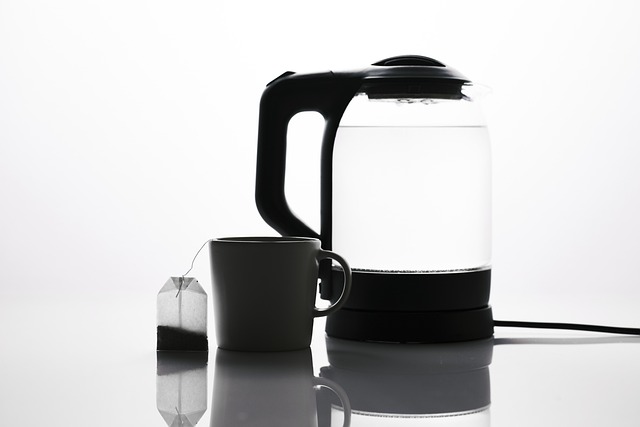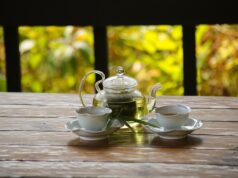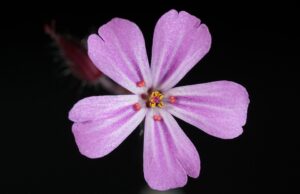Contents
Introduction
Throughout history, tea has been a cherished beverage in many cultures around the world. Brewing the perfect cup of tea requires more than just the right blend of leaves; it also involves the use of the right tools. One of the most iconic tools used for brewing tea is the cast iron stovetop tea kettle.
Steeped in tradition, cast iron tea kettles have been an essential part of tea rituals for centuries. These kettles are not only functional but also carry a rich history that has evolved over time.
In this article, we will delve into the fascinating history and evolution of cast iron stovetop tea kettles. From their origins in ancient China to their popularity in Western cultures, these tea kettles have stood the test of time and continue to be beloved by tea enthusiasts around the world.
The History and Evolution of Cast Iron Stovetop Tea Kettles
The Origins of Tea Kettles
Tea kettles have been an integral part of tea culture for centuries. The earliest records of tea kettles date back to ancient China, where they were primarily made from bronze or iron. These kettles were initially used to heat water for medicinal purposes, but their function soon expanded to include tea preparation.
Throughout history, tea kettles have not only evolved in design and materials but have also become symbols of hospitality, comfort, and tradition.
The Emergence of Cast Iron Stovetop Tea Kettles
Cast iron stovetop tea kettles rose to popularity during the 19th century. With the advent of modern manufacturing techniques, cast iron became more accessible and affordable, making it a preferred material for tea kettle production.
The main advantage of cast iron tea kettles is their excellent heat retention properties. They distribute heat evenly, allowing for a steady and controlled boiling process, which is crucial for making the perfect cup of tea. The durability of cast iron also ensures that these kettles stand the test of time.
The Influence of Tradition
In many cultures, particularly in East Asia, the use of cast iron tea kettles is deeply rooted in tradition. These kettles are often regarded as heirlooms, passed down through generations, carrying with them the memories and stories of the family.
The distinct aesthetic of cast iron tea kettles, often adorned with intricate designs and patterns, adds to their allure. Their timeless elegance and connection to tradition make them a beloved and cherished item in many households.
Modern Adaptations and Variations
With the advancement of technology and the ever-changing needs of tea aficionados, cast iron tea kettles have undergone adaptations and variations. Modern designs now feature enhanced functionality, such as heat-resistant handles and spouts designed for precise pouring.
Additionally, tea lovers can now find cast iron tea kettles with enamel coatings, which not only add vibrant colors to the kettle but also prevent rusting and make cleaning easier.
Experience the Legacy
If you’re looking to experience the rich history and legacy of cast iron stovetop tea kettles, consider adding one to your collection. These kettles offer a unique brewing experience and add a touch of elegance to any tea ceremony.
Visit our website to explore a wide range of cast iron tea kettles and immerse yourself in centuries-old tradition.
Frequently Asked Questions
1. What is the history behind cast iron stovetop tea kettles?
Cast iron stovetop tea kettles have a rich history that dates back to ancient times. In Asia, cast iron teapots were widely used as early as the 17th century. The tradition of using cast iron for heating water and steeping tea spread to Europe and later to other parts of the world.
2. How are cast iron stovetop tea kettles different from other types of tea kettles?
One of the main differences is the material. Cast iron tea kettles have excellent heat retention properties, ensuring that water stays hot for longer periods of time. They also tend to be more durable and long-lasting compared to kettles made of other materials.
3. Are cast iron stovetop tea kettles safe to use on all types of stovetops?
Yes, most cast iron stovetop tea kettles are safe to use on all types of stovetops, including gas, electric, and induction. However, it is always recommended to check the manufacturer’s instructions to ensure compatibility.
4. How should I clean and care for a cast iron stovetop tea kettle?
To clean a cast iron stovetop tea kettle, simply rinse it with warm water and mild soap. Avoid using abrasive cleaners or steel wool, as they can damage the enamel coating. It’s also important to dry the kettle thoroughly after each use to prevent rusting.
5. Can I use my cast iron stovetop tea kettle to brew tea?
Yes, cast iron stovetop tea kettles are designed for brewing tea. Their heat retention properties and even heat distribution make them ideal for steeping tea leaves and infusing flavors.
6. Are there any special tips for using a cast iron stovetop tea kettle?
It is recommended to preheat the kettle before adding water to enhance the heat retention. Additionally, avoid leaving water in the kettle for extended periods as this can lead to rusting. Regularly seasoning the kettle with oil can help maintain its longevity.
Why a Cast Iron Stovetop Tea Kettle is Perfect for Tea Enthusiasts
Benefits of Using a Cast Iron Stovetop Tea Kettle
A cast iron stovetop tea kettle is a must-have for tea enthusiasts looking to elevate their tea-drinking experience. With its timeless design and numerous benefits, it has become a popular choice among tea lovers. Here are some reasons why you should consider using a cast iron stovetop tea kettle:
- Superior Heat Retention: The cast iron material used in these tea kettles allows for excellent heat retention, ensuring that your water stays hot for longer periods. This is particularly useful when making multiple cups of tea or hosting tea parties.
- Even Heat Distribution: One of the advantages of cast iron is its ability to distribute heat evenly. This ensures that your tea is brewed consistently and thoroughly, enhancing the flavor and aroma of your tea.
- Durable and Long-lasting: Cast iron tea kettles are known for their durability, with the potential to last for generations. They are resistant to scratches, stains, and chipping, making them a reliable long-term investment.
Tips for Using and Maintaining a Cast Iron Stovetop Tea Kettle
To make the most out of your cast iron stovetop tea kettle, here are some useful tips to follow:
- Season Your Kettle: Before using your new cast iron tea kettle, it is recommended to season it to build a protective layer on its surface. This can be done by applying a thin coat of vegetable oil and heating it gently.
- Handle with Care: Cast iron tea kettles can be heavy, so it’s crucial to handle them with care. Use oven mitts or potholders to protect your hands while handling the kettle.
- Proper Cleaning: Avoid using soap when cleaning your cast iron stovetop tea kettle, as it may strip away the seasoning. Instead, rinse it with hot water and gently scrub with a soft brush. Afterward, thoroughly dry the kettle to prevent rusting.
For more detailed information about cast iron stovetop tea kettles, you can visit the Wikipedia page on tea kettles.
Steeped in Tradition: The History and Evolution of Cast Iron Stovetop Tea Kettles
Overview
- Introduction to the history and evolution of cast iron stovetop tea kettles
Early Origins
- Tracing the use of cast iron in tea kettle production back centuries
- The influence of Asian tea culture on early cast iron tea kettle designs
Industrial Revolution
- The rise of mass production and affordability of cast iron tea kettles during the Industrial Revolution
- Integration of new techniques and materials for improved functionality and design
Popularity and Nostalgia
- The enduring appeal of cast iron tea kettles in modern times
- Connection to nostalgia for traditional tea preparation methods
Contemporary Innovations
- The incorporation of modern features and advancements while preserving the classic cast iron aesthetic
- New materials and construction methods for enhanced durability and heat distribution


































